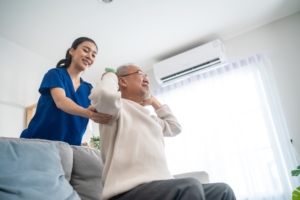Best Practices for Preventing Falls
 Taking the wrong step or losing balance, even for a brief moment, can cause a debilitating fall. For adults 65 years and older, a simple fall can have a lasting impact. According to the Centers for Disease Control and Prevention (CDC), falls are the leading cause of injury for this age group. Homeland’s team of highly trained professionals understands the importance of fall prevention and incorporates safety measures and education into its way of work to provide the best care possible for clients and patients.
Taking the wrong step or losing balance, even for a brief moment, can cause a debilitating fall. For adults 65 years and older, a simple fall can have a lasting impact. According to the Centers for Disease Control and Prevention (CDC), falls are the leading cause of injury for this age group. Homeland’s team of highly trained professionals understands the importance of fall prevention and incorporates safety measures and education into its way of work to provide the best care possible for clients and patients.
Karen Paterson, an occupational therapist and quality control coordinator has worked for Homeland since 2017. In her role as a therapist, she works directly with clients and patients. She also evaluates Homeland’s services to ensure the highest standards of safety are met. From her experience, teaching people how to establish and maintain balance is key to preventing falls.
“I teach people to follow the CDC’s balance test,” Karen says. “These four stances can reduce the risk of falls.”
The 4-stage balance test includes standing in the following positions for 10 seconds:
- Stand with feet side-by-side.
- Place the instep of one foot so it is touching the big toe of the other foot.
- Place one foot in front of the other so the heel touches the toe.
- Stand on one foot.
Understanding and regularly practicing this test can give people confidence in their balance as well as identify areas of weakness in the body to focus on strengthening. Movement and increased flexibility are essential to engage our body’s muscles and build muscle memory.
In addition to the lower extremities, Karen recommends focusing on neck and upper body flexibility with simple exercises such as like turning one’s neck slowly to the left and right, chin tucks and shoulder shrugs. The culmination of these practices can help people get to know their body and movements.
“Our night vision can be limited,” Karen adds. “Knowing how our body moves can help us navigate our steps.”
Simple adjustments to the layout and lighting of one’s home is another important factor in preventing falls. Modifications like no-skid bathmats and proper lighting can make a significant difference in safety. Other recommended adjustments include adding shower bars, clearing walking spaces and removing throw rugs.
Through Homeland’s outreach services which include Homeland Hospice, Homeland HomeHealth, Homeland HomeCare and Homeland Palliative Care, each person is given a comprehensive assessment to develop a unique care plan to meet individualized needs. The safety of clients and patients is the foundation of all plans.
During her time making home visits, Karen gets to know her clients and patients well. For some people, visits from Homeland staff are the only visits they receive, which makes observations of their behavior and movement so important to their safety.
“Prevention is key,” Karen says. “We want everyone we serve to have the best life possible.”


